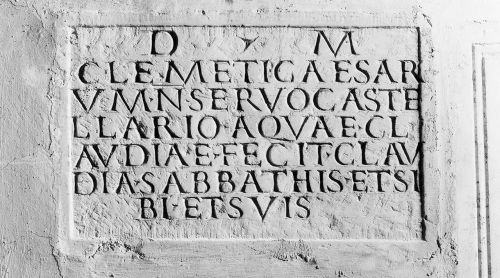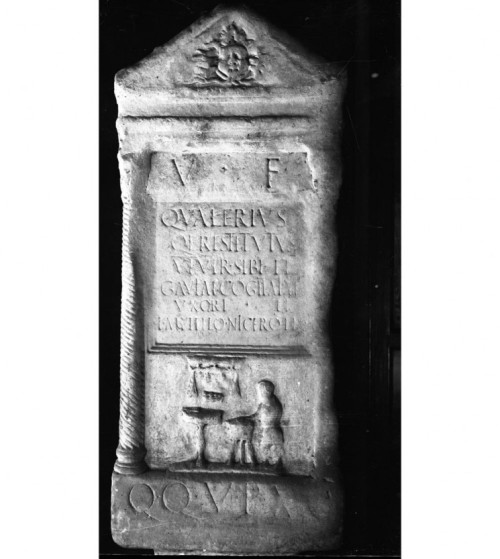#epigrafia
Marble slab from the family tomb of a castellarius
The inscription reads:
D(is) M(anibus) / Cleme(n)ti Caesar/um n(ostrorum) / servo caste/llario aquae Cl/audiae fecit Clau/dia Sabbathis et si/bi et suis
The deceased, Clemens, controlled the distribution tanks (castella) of the Aqua Claudia (initiated by Caligula in 38 and completed by Claudius in 52), mentioned in the epigraph of the arches (now Porta Maggiore) incorporated in the Aurelian Walls (the final part of a 69 km path fed by springs from the upper valley of the River Aniene). The massive water system that served the capital of the Empire, described in a monograph by Frontinus, alone offers an indication of the magnificence of the city, divided into 14 regions and filled with fountains and thermal baths. Clemens was buried by his wife who bears, alongside a name of Semitic origin (Sabbathis), the same family name as Claudius. Perhaps the deceased (referred to generically as “slave of our Caesars”) belonged to this emperor and others who succeeded him rather than to the two co-reigning emperors: Marcus Aurelius and Lucius Verus (161-169 A.D.), M. Aurelio and Comodo (177-180 A.D.) or Septimius Severus and Caracalla (198-209 A.D.).
From Rome, unknown burial monument
Second half of the first – late second century A.D.
© Roma, Musei Vaticani, Galleria Lapidaria
Post link
Funerary stele, made of limestone, of the freedman and sevir Q. Valerius Restitutus. Still alive, he erected the funeral monument for himself, for his wife and for Lucius Metellus Niceros. The structure has two columns on the sides with corinthian capitals, a pediment with Gorgon’s face, and perhaps two corner acroteria in the shape of lions. There is a bass-relief in the lower part with an artisan, maybe an aurifex brattiarius, a jewellery maker, or a lanius, butcher. The second hypothesis is supported by the discovery of a boundary stone with the figure of a bull on the pediment and an inscription which indicates the same dimensions of the funerary area (20 x 20 roman feet).
The text reads:
V(ivus) f(ecit) / Q(uintus) Valerius / Q(uinti) l(ibertus) Restitutus / VIvir sibi et / Gaviae Cogitatae / uxori et / L(ucio) Metello Niceroti / q(uo)q(uo)v(ersus) p(edes) XX
First half of 1st century AD
@ Archaeological Museum of Bologna
Post link
Marble funerary Inscription of Caecilius Hilarius, physician to the famous Caecilia Metella. Her circular tomb is still seen as a large monument on the Appian Way south of Rome.
The inscription reads:
Q(uintus) Caecilius Caeciliae / Crassi〈uxoris〉 l(ibertus) Hilarus, medicus,
/ Caecilia duarum / Scriboniarum l(iberta) / Eleutheris, / ex partem dimidiae sibi êt suis.
meaning: “Quintus Caecilius Hilarus, a doctor, / Freedman of Caecilia, wife of Crassus. / Caecilia Eleutheris, freedwoman of / two Scriboniae. With the share of a half. / For himself (themselves?) and their (family).”
The doctor’s praenomen Quintus was taken from the name of Caecilia Metella’s father. Caecilia Eleutheris was Hilarus’ wife. She was the freedwoman of the two “Scriboniae,” one of whom was the first wife of Augustus (40-39 BC) and mother of his only child, Julia. The other sister was married to the son of Pompey the Great, Sextus Pompeius, who was defeated by Augustus/Octavian in 36 BC.
In the second line, the inscriber ran out of space and put the final “us” of “medicus” in small letters.
27 BC / 14 AD.
Found in Rome on the via Salaria in the so-called “Monumentum Caeciliorum“.
© Harvard Art Museums, Cambridge, MA
Post link



